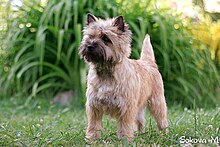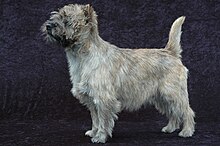This is an old revision of this page, as edited by 86.137.177.220 (talk) at 03:01, 14 April 2023 (→Living conditions: Del poorly written unsourced POV). The present address (URL) is a permanent link to this revision, which may differ significantly from the current revision.
Revision as of 03:01, 14 April 2023 by 86.137.177.220 (talk) (→Living conditions: Del poorly written unsourced POV)(diff) ← Previous revision | Latest revision (diff) | Newer revision → (diff) Scottish dog breed| This article needs additional citations for verification. Please help improve this article by adding citations to reliable sources. Unsourced material may be challenged and removed. Find sources: "Cairn Terrier" – news · newspapers · books · scholar · JSTOR (November 2020) (Learn how and when to remove this message) |
| Cairn Terrier | |||||||||||||||||||||
|---|---|---|---|---|---|---|---|---|---|---|---|---|---|---|---|---|---|---|---|---|---|
 Two Cairn Terriers showing variations in coat colour Two Cairn Terriers showing variations in coat colour | |||||||||||||||||||||
| Origin | Scotland | ||||||||||||||||||||
| |||||||||||||||||||||
| |||||||||||||||||||||
| Dog (domestic dog) | |||||||||||||||||||||
The Cairn Terrier is a terrier breed originating in the Scottish Highlands and recognized as one of Scotland's earliest working dogs.
The name “Cairn Terrier” was a compromise suggestion when the breed was brought to official shows in the United Kingdom in 1909, initially under the name “Short-haired Skye terrier”. This name was not accepted by The Kennel Club when faced with opposition from breeders of the Skye Terrier. The alternative name Cairn Terrier was adopted.
History
Cairn terriers originated in the Scottish Highlands and the Isle of Skye, initially grouped in the "Skye Terrier" class alongside the Scottish and West Highland White Terriers. From the early 1900s, the three were bred separately.
The Kennel Club of the United Kingdom gave the Cairn Terrier a separate register in 1912; the first year of recognition, 134 were registered, and the breed was given Championship status.
Description


The Cairn Terrier has a harsh weather-resistant outer coat that can be black, cream, wheaten, red, sandy, gray, or brindled. Pure black, black and tan, and white are not permitted by many kennel clubs. While registration of white Cairns was once permitted, after 1917, the American Kennel Club required them to be registered as West Highland White Terriers. A notable characteristic of Cairns is that brindled Cairns frequently change colour throughout their lifetimes. It is not uncommon for a brindled Cairn to become progressively more black or silver as it ages. The Cairn is double-coated, with a soft, dense undercoat and a harsh outer coat. A well-groomed Cairn has a rough-and-ready appearance, free of artifice. The Cairn Terrier was registered into the American Kennel Club in 1903.

Cairn Terriers tend to look similar to Norwich Terriers, but with some differences (for example the shaggy fur). The outer layer of fur is shaggy, but they have a soft, downy undercoat. The ideal weight is 4.5-7.3 kg (10-16 lb), and the height 9–13 in (23–33 cm).
Grooming

Cairn Terriers shed very little, but always should be hand-stripped. Using scissors or shears can ruin the dog's rugged outer coat after one grooming. Hand-stripping involves pulling the old dead hair out by the roots. If done incorrectly, this can cause discomfort to the dog, causing it to shy away from future hand-stripping. Removing the dead hair in this manner allows new growth to come in. This new growth helps protect the dog from water and dirt.
Cairn Terrier ancestors are from Scotland, where the wire coat repels water and keeps the dog dry even in rainy or damp climates. Keeping the Cairn Terrier coat in its original state will prevent possible skin irritations. As dead hair is removed by stripping the coat, new growth comes in, and the skin and coat remain healthy. Clipper-cutting a Cairn might destroy the protective wire coat unique to this breed.
Health
These dogs are generally healthy and live on average about 12 to 17 years.
Survey
Breeders, owners, and veterinarians have identified several health problems that are significant for Cairns. Some of these diseases are hereditary, and others occur as a result of nonspecific factors (e.g., infections, toxins, injuries, or advanced age).
Currently, the Cairn Terrier Club of America, along with the Institute for Genetic Disease Control in Animals, maintains an open registry for Cairn Terriers in hopes of reducing the occurrence of hereditary diseases within the breed. Breeders voluntarily submit their dogs' test results for research purposes as well as for use by individuals who seek to make sound breeding decisions.
Some of the more common hereditary health problems found in the Cairn are:
- Bronchoesophageal fistula
- Cataracts
- Corneal dystrophy
- Craniomandibular osteopathy (lion jaw)
- Diabetes mellitus
- Entropion
- Hip dysplasia
- Hypothyroidism
- Krabbe disease (globoid cell leukodystrophy)
- Legg–Calvé–Perthes disease
- Lens luxation
- Luxating patella
- Ocular melanosis
- Portosystemic shunt
- Progressive retinal atrophy
- Soft-tissue sarcoma
- Von Willebrand disease
Living conditions
| This section does not cite any sources. Please help improve this section by adding citations to reliable sources. Unsourced material may be challenged and removed. (February 2012) (Learn how and when to remove this message) |

Cairn Terriers exist happily in an apartment when sufficiently exercised.
Exercise
Cairns are active dogs, thus need a daily walk. Play takes care of a lot of their exercise needs; however, as with all breeds, play will not fulfill their primal instinct to walk. Dogs which do not get to go on daily walks are more likely to display behavior problems. They also enjoy a good romp in a safe, open area off leash, such as a large, fenced yard.
According to Temple Grandin in her book Animals Make Us Human, dogs need 45 minutes to one hour per day of playing and seeking. Being a new owner of one, play time is more like two hours per day for this breed. After fulfilling this, dogs become balanced and well-mannered. Obedience school is often a good start to creating interactive play using words or commands for a dog to perform specific actions on cue. Teaching a Cairn Terrier tricks is also a clever way to direct their active energy into acceptable, controlled dog games.
See also
References
- "Cairn Terrier History". American Kennel Club. Retrieved 26 October 2014.
- "swwectc- cairn history". www.swwectc.freeuk.com. Archived from the original on 2018-10-18. Retrieved 2016-11-26.
- "Individual Breed Results for Purebred Dog Health Survey".
- Leroy, G. G.; Phocas, F.; Hedan, B.; Verrier, E.; Rognon, X. (2015). "Inbreeding impact on litter size and survival in selected canine breeds" (PDF). The Veterinary Journal. 203 (1): 74–8. doi:10.1016/j.tvjl.2014.11.008. PMID 25475165. mean=12.23 ± 4.18 median=13.42
- "Health Related Concerns". Cairn Terrier Club of America Inc. Archived from the original on 7 May 2010. Retrieved 12 May 2010.
- Alex., Gough (2004). Breed predispositions to disease in dogs and cats. Thomas, Alison, 1964–. Oxford, UK: Blackwell Pub. ISBN 978-1405107488. OCLC 53231203.
External links
| Dogs originating in the United Kingdom | |||||||
|---|---|---|---|---|---|---|---|
| Hounds | |||||||
| Gun dogs | |||||||
| Terriers |
| ||||||
| Herding dogs | |||||||
| Other | |||||||
| Extinct |
| ||||||
| |||||||
| Scottish domestic animal breeds | |
|---|---|
| |
| Cattle | |
| Dogs | |
| Horses | |
| Pigs | |
| Poultry | |
| Sheep | |